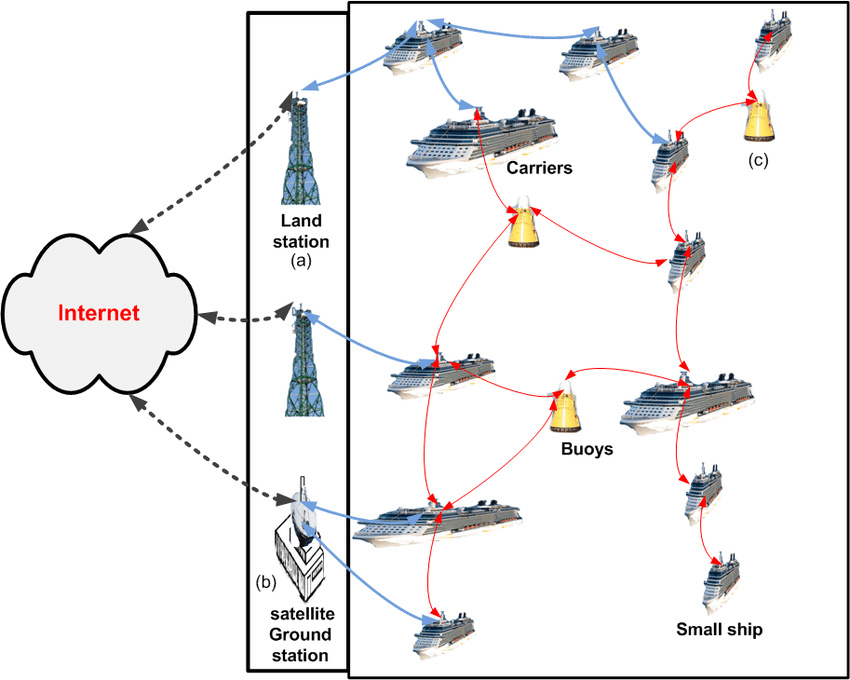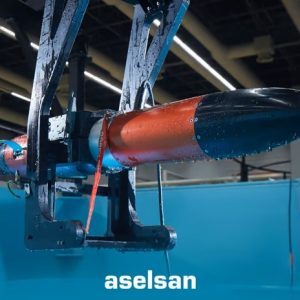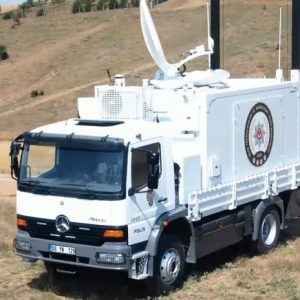Navies and defence research agencies are quietly advancing **maritime mesh networking** architectures. These include deployable floating radio nodes, sea‑surface relays, and hybrid hop‑mesh links. Together, they aim to keep JADC2‑grade connectivity alive in contested littorals and spectrum‑denied waters. The concept is straightforward yet potent: scatter affordable nodes that talk to each other and to higher‑tier networks. As a result, command‑and‑control can continue even when satellites or line‑of‑sight paths are jammed, obstructed, or unavailable.
Why it matters: In degraded maritime environments, conventional satellite and line‑of‑sight radios become fragile single points of failure. By contrast, a distributed sea‑surface mesh preserves essential communications, coordinates dispersed sensors and unmanned systems, and provides reach‑back to maneuver forces. Consequently, naval resilience strengthens across multiband, multi‑domain campaigns.
Key Facts
SBIR topic: The U.S. Navy solicited an SBIR topic titled “Utilizing Mesh‑Networking for Greater Maritime Situational Awareness,” calling for floating mesh payloads capable of multi‑hop relays and gateway links to airborne or satellite nodes. [1]
RFI call: A mesh network broadcast relay RFI posted on SAM.gov signaled interest in relay capabilities for naval and defence roles using broadcast propagation over tactical meshes. [2]
Modernization path: U.S. Navy networking modernization (for example, Project Overmatch and NetANTX) is pushing toward resilient, distributed links, and tactical mesh protocols are now being evaluated for maritime operations. [3]
Phase and scale: Current efforts remain early R&D and prototyping (SBIR, RFIs), not full‑fleet programs. Therefore, the window for SME experimentation is open.
Dual‑domain bridges: Sea‑surface mesh nodes can bridge ships, UAV relays, and satellites. In practice, they provide a dynamic “last mile” in complex maritime topologies.
From brittle links to adaptive seas
Traditional naval networking leans on satellites, line‑of‑sight radios, and fixed subsea cables. In a major‑power confrontation, each can be jammed, intercepted, or physically degraded. Maritime mesh networking changes the geometry. Instead of forcing everything through a few fat pipes, it uses many small, redundant routes. Floating, drifting, or anchored nodes hop messages along paths that adapt to conditions. Even with modest bandwidth, a robust mesh can carry command messages, targeting updates, blue‑force tracking, and urgent alerts.
The Navy’s SBIR topic seeks precisely this capability: sea‑worthy relay nodes that survive spray, corrosion, and wave motion while forming multi‑hop paths to aircraft, satellites, or shore gateways. [1] In parallel, a Mesh Network Broadcast Relay RFI on SAM.gov highlights broadcast‑over‑mesh modes for naval scenarios. This is useful for delivering the same critical warning to many receivers even as routes flex around interference. [2] Defence trade reporting, including Janes, links these signals to the Navy’s push for distributed networks under Project Overmatch and NetANTX. [3]
Technical and operational implications
Multi‑hop over curved seas. Sea‑surface relays reduce reliance on direct line‑of‑sight. Nodes pass traffic across the horizon and around clutter. As topology changes, routing adapts to sustain flows despite movement or node loss.
Bridging domains. A surface mesh provides the “last nautical mile” to airborne repeaters, LEO gateways, or high‑power ship radios. In combined arms, this keeps USVs, AUVs with pop‑up masts, and dispersed patrol craft on the same digital page.
Resilience under attack. With route diversity and frequency agility, mesh architectures are harder to jam or geolocate than monolithic emitters. Even if an adversary knocks out part of the grid—or captures a node—the remainder can re‑route and continue to relay validated traffic.
Throughput reality. Mesh links at sea will often deliver low‑to‑moderate bandwidth. This pushes adoption of content prioritization (for instance, cursor‑on‑target and brevity codes), compression, link‑agnostic protocols, and—crucially—edge processing. In short, send decisions, not raw data.
Power and survivability. Endurance favors hybrid power (solar, batteries, and possibly micro wave‑energy harvesters), high‑IP enclosures, auto‑righting forms, and antifouling coatings. Field logistics should include rapid deployment kits, recovery tools, and low‑signature housings to cut visual and RF detectability.
Timing, PNT, and trust. Reliable timing and geo‑referencing are non‑negotiable. Where GNSS is denied, nodes may require alternative timing (chip‑scale atomic clocks or cooperative time transfer) and robust authentication to keep spoofed traffic out.
Procurement horizon and standards
For industry, the signals point to a near‑term window where small and mid‑size firms can shape the Navy’s playbook. SBIR pathways fund early prototypes. RFIs map the requirement space. Experiments under Project Overmatch and NetANTX can carry promising ideas into programs of record. Allied cooperation and coalition operations also imply a standards conversation that spans waveform interoperability, crypto, and management of drifting, attritable nodes across national task groups. NATO AEP‑series guidance is a plausible venue to socialize practices before formal standards emerge.
Scaling beyond prototypes will demand modularity. Designers should consider swappable radio stacks (VHF/UHF/L‑band/HF), optional SATCOM gateways, and interface profiles to common combat system buses. Sustainment planning should include LRIP support, refurb kits for saltwater exposure, and exercises that seed meshes during littoral training, amphibious rehearsals, and distributed maritime operations.
Risks, alternatives, and complements
Environmental stress. Waves, storms, and biofouling will break weak designs. Mesh nodes must be robust and easy to recover. Redundancy should cover expected attrition.
Bandwidth and latency. Multi‑hop paths plus modest radios mean tight budgets. Doctrine will likely steer away from video and toward event‑driven messages, compact track updates, and machine‑parsable cues.
Physical vulnerability. Adversaries can target or trawl nodes. Low‑observable housings, decoy nodes, and strong encryption with rapid key rotation raise the cost of exploitation.
Underwater acoustics as a foil. Subsea acoustic relays offer stealth but far lower data rates. The likely answer is a layered approach: acoustics below, RF mesh at the surface, and aerial or satellite overlays above—stitched by smart gateways.
What’s next
Expect two to three years of prototyping with instrumented trials at naval test ranges. If demonstrations prove reliable routing under stress, sea‑surface mesh relays will appear in major exercises and coalition events. The tipping point is doctrinal. Once commanders plan with a “throw‑down mesh” in their connectivity toolkit, requirements will expand. We should then see standard payload bays on USVs, palletized buoy kits for RHIBs, and quick‑start playbooks for disaster relief and grey‑zone patrols.
Internal & external links
Internal: Link‑16 phaseout & optical backbone · Naval USV autonomous launch & recovery
External: U.S. Navy SBIR — Mesh‑Networking for Maritime SA · SAM.gov — Mesh Network Broadcast Relay (RFI) · Janes — Tactical mesh in maritime ops











